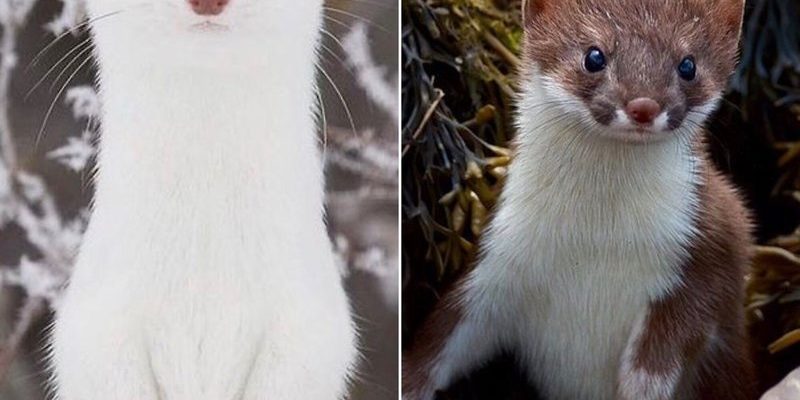![Comparing The Stoat Vs. [Similar Species]](https://gudri.com/wp-content/uploads/2025/06/Comparing_The_Stoat_Vs___Similar_Species__image_0.jpg)
Both stoats and weasels belong to the same family, Mustelidae, which includes other playful animals like otters and badgers. Yet, the stoat and weasel each have unique traits that make them suited to different habitats and lifestyles. Let’s dive into the fascinating world of these small mammals and explore what truly differentiates a stoat from a weasel.
Physical Characteristics: Size and Appearance
One of the first things you’ll notice when comparing stoats and weasels is their size. **Stoats** (Mustela erminea) are typically larger, measuring about 12–30 inches long, including their bushy tail. They often weigh between 1.5 to 3.5 pounds. When it comes to appearance, stoats have a sleek, elongated body and a variable coat that changes from brown in summer to a striking white in winter, often with a black tip on their tail.
On the other hand, **weasels** (Mustela nivalis) are smaller, averaging around 6–12 inches in length, with a weight of just a few ounces. Their bodies are slimmer, and they typically have a similar coat color that also changes with the seasons—brown in summer and white in winter—though the change isn’t as dramatic as that of the stoat. This size difference is more than just a fun fact; it affects their hunting strategies and habitats.
Habitat and Distribution
Both stoats and weasels can be found in various environments, but their preferred habitats often differ. **Stoats** tend to favor open fields, woodlands, and even mountains, where they can use their agility to chase down prey. They’re more often found in areas with ample cover, like bushes or thick grasses.
In contrast, **weasels** are adaptable and can live in a variety of habitats, including forests, grasslands, and even urban areas. They thrive in places with a good supply of small rodents for hunting. While both animals are found across Europe, North America, and parts of Asia, stoats are more likely to be seen in colder, northern climates than weasels. Understanding their habitat preferences helps us appreciate their survival strategies in the wild.
Diet and Hunting Behaviors
When it comes to food, stoats and weasels share some similarities, but their hunting styles reveal interesting differences. **Stoats** are fierce hunters; they primarily prey on small mammals like rabbits, voles, and even birds. They’re known for their impressive agility and ability to take down prey larger than themselves. Stoats can leap into the air to catch birds or sprint through underbrush to ambush small mammals.
**Weasels**, on the other hand, focus mainly on smaller animals like mice, shrews, and insects. Their hunting technique revolves around stealth and quick strikes. They’re known for their incredible speed, allowing them to dart in and out of burrows to catch their prey. Both animals play a vital role in controlling rodent populations, but the stoat’s size enables it to tackle larger prey, while the weasel excels in hunting the smaller critters that might slip through the stoat’s grasp.
Behavior and Social Structure
Let’s talk about personality—yes, even animals have their quirks! **Stoats** tend to be solitary creatures. They’re territorial and will fiercely defend their hunting grounds from other stoats. Their aggressive behavior can seem surprising, given their size, but this trait helps them survive in the wild. Stoats communicate through a range of sounds, from chirps to growls, expressing their moods and intentions.
In contrast, **weasels** can be more social, often found in pairs or small family groups, especially during breeding season. They engage in playful behaviors, sometimes wrestling with one another, which may help young weasels learn to hunt. Their ability to communicate and bond with others can create a support system that benefits all members of the group, especially when it comes to hunting and protecting their territory.
Reproduction and Lifespan
Reproductive behaviors also differ between stoats and weasels. **Stoats** have a unique breeding cycle; females can delay fertilization, resulting in a birth timeframe that aligns with the best conditions for the young. They typically have one litter per year, with 5-10 kits. The kits are born in a hidden den and are cared for by the mother until they can fend for themselves.
**Weasels**, however, may also have one litter per year, but their breeding can be less synchronized with environmental conditions. They usually have smaller litters of 3-6 kits. Once again, the parenting strategy gives weasels a slight edge in adaptability to various environments. In the wild, both stoats and weasels have a lifespan of about 1-3 years, but some can live longer in protected conditions.
Conservation Status
Understanding the conservation status of stoats and weasels is crucial for their future. **Stoats**, while common in many areas, face threats from habitat loss and climate change, which can disrupt their hunting grounds. In some regions, they are considered a species of least concern, but monitoring their populations is important to prevent decline.
**Weasels** are also widespread and have adapted well to different environments. However, they can be affected by habitat destruction and changes in prey availability. Keeping their populations stable is vital for maintaining ecological balance, as both species are essential for pest control.
Final Thoughts: Celebrating the Differences
So, there you have it—stoats and weasels may look similar, but they’re like two different chapters in the same fascinating book of nature. They illustrate how diverse life can be, even among similar species. Whether you’re lucky enough to spot a stoat bounding through a meadow or a weasel sneaking through tall grass, take a moment to appreciate these remarkable animals and their unique place in the ecosystem.
Learning about stoats and weasels not only satisfies our curiosity but also reminds us of the delicate balance in nature. Every creature has its role, and understanding them is a step toward preserving their habitats for future generations.

